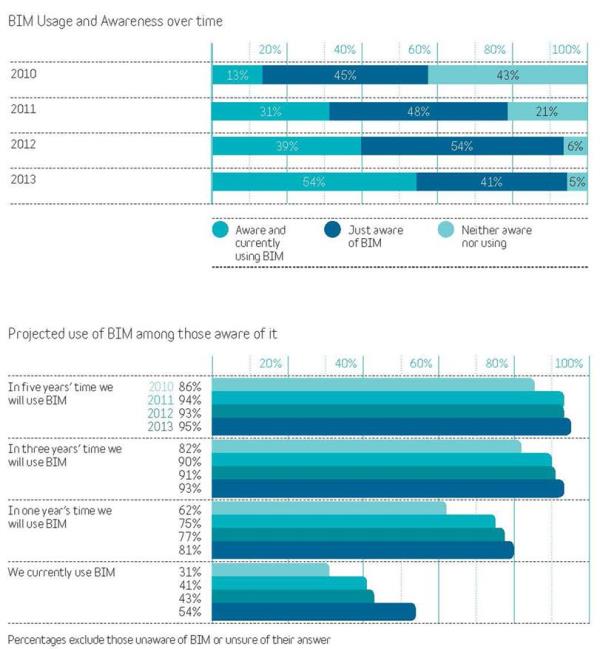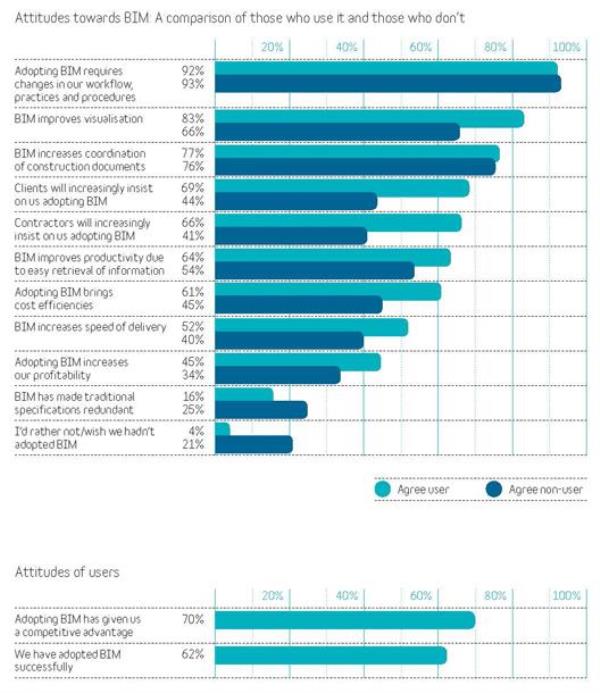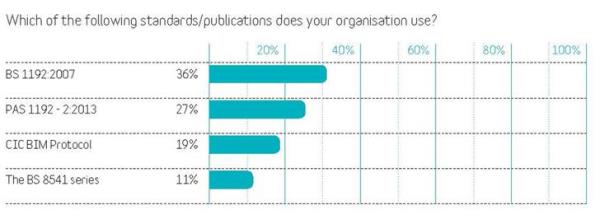In the UK, through BIM, we are at the forefront of a significant change in how buildings are conceived, designed, built and maintained. This change has the potential to bring improved efficiencies and profitability to the construction sector, and deliver better buildings to clients.
The following four points provide an insight into how BIM is used and perceived within the industry. You can download the full NBS National BIM Report 2014 ![]() for free.
for free.
Awareness of BIM is near universal
It has risen from 58% in 2010 to 95% in 2013. Now only 5% of participants are unaware of BIM. Contrast this with 2010, when 43% of respondents had not heard of BIM. This rise may be because the Government has mandated use of BIM for publicly-funded projects by 2016, less than two years away. Awareness has increased, and so too has adoption.

The top five barriers to BIM adoption among smaller organizations
There is some commonality. For both smaller and larger organizations, cost is a barrier, with 67% of smaller organizations and 64% of larger ones citing it. A lack of in-house expertise is a barrier to both groups as well, with over three quarters of larger organizations mentioning it and 62% of smaller ones.
For smaller organizations, client demand is the highest barrier to BIM adoption. Whilst the Government enforces BIM for publicly-funded work, clients of smaller organizations don’t often make similar demands. 63% of small organizations tell us that the projects they work on are ‘too small’ to warrant BIM and 71% that BIM is ‘not relevant to the projects we work on’ – perhaps because the level of complexity just isn’t there to warrant BIM.
There is a risk here that we can describe in two ways: either that the Government, through its BIM strategy, is excluding smaller organizations from a significant source of revenue (publicly funded work), or that smaller organizations need to adopt BIM to prepare themselves for 2016 (as many are already doing).
In any case, if BIM is to become a tool for all designers, there is work to be done, not only by smaller practices but also by the wider industry.

Attitudes towards BIM: A comparison of those who use it and those who don’t
Only 4% wished that they hadn’t adopted BIM, whilst 21% of non-users would rather not adopt BIM. More importantly perhaps, 61% of users found that BIM brought cost efficiencies, 52% that it increased the speed of delivery and 45% agreed that it increased profitability (16% disagreed; the remainder, 39%, were neutral). Those who have adopted BIM predict that both clients and contractors will insist on the adoption of BIM. With unremitting pressure on architects’ and others’ professional fees, it looks as if BIM may offer a way to getting more work, and making that work more profitable.
For those who have adopted BIM, the data is unequivocal. The experience of those who have adopted BIM shows us that the process, whilst not easy, is worthwhile. It delivers a competitive advantage.

“BIM will not be successful until there is a robust standard for the exchange of BIM information.”
For collaboration to be successful, collaborating parties need to use agreed standards. Only 24% agreed that the current level of standardization is right, suggesting that the construction industry needs to implement a greater degree of standardization for BIM adoption to be successful.

With 36% using BS 1192:2007 and 27% using PAS 1192-2:2013, we can see that a significant number of respondents use standardized processes for the ownership, review and sign-off of information, before that information is more widely shared. This is crucial for larger projects and practices where information goes across and beyond the design team.
These findings were originally published as part of the NBS National BIM Report 2014 ![]() which you can download for free.
which you can download for free.

